1993 VOLKSWAGEN GOLF fuel
[x] Cancel search: fuelPage 75 of 156
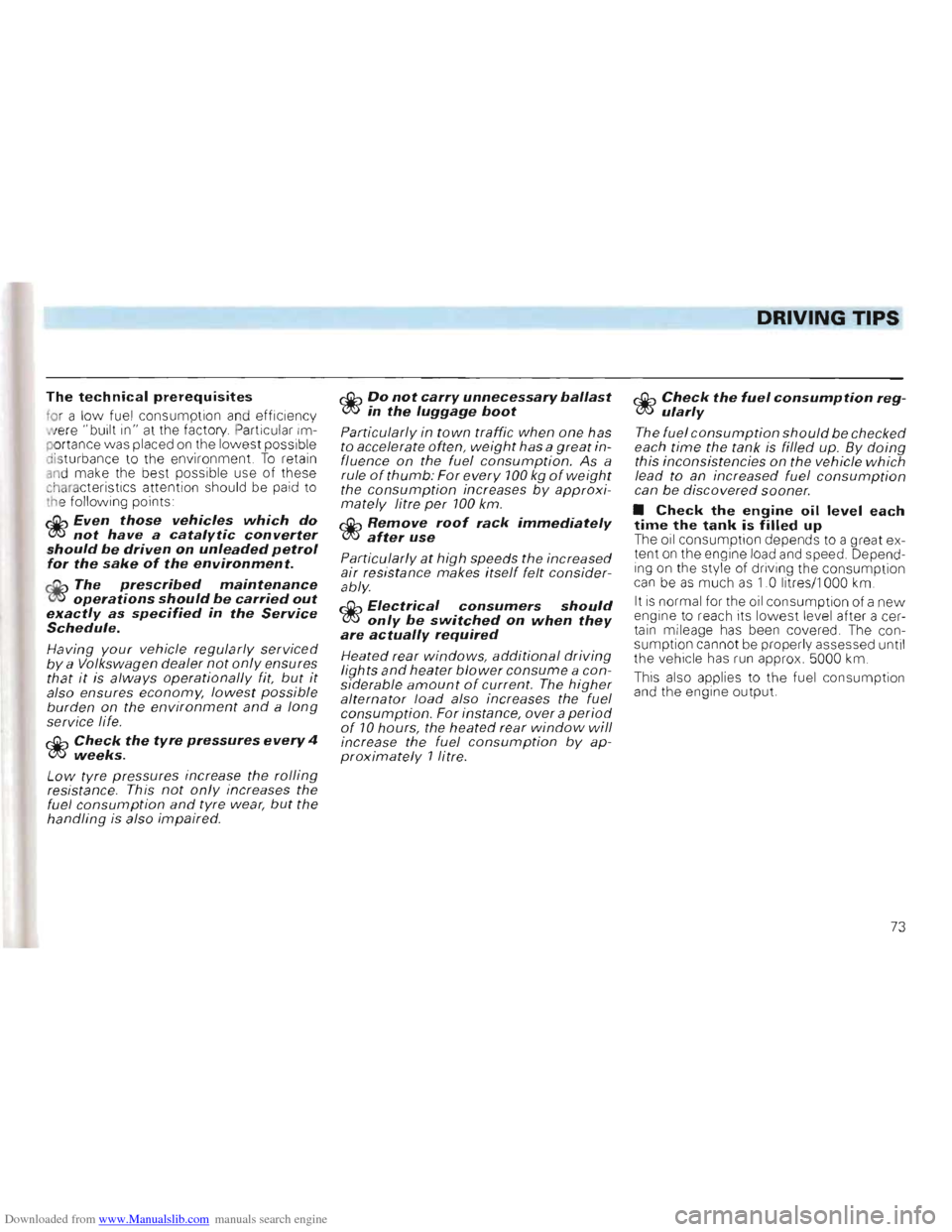
Downloaded from www.Manualslib.com manuals search engine DRIVING TIPS
The technical prerequisites
for a low fuel consumpt ion and efficienc y "" ere " built in" at the factory. Particular Im
p ortance was placed on the lowes t possible
d is turban ce to the enviro nme nt. To retain and make the best possible use of these characteristics attent ion should be paid to the fo llow ing points
~Even those vehicles which do W not have a catalytic converter should be driven on unleaded petrol for the sake of the environment.
~The prescribed maintenance W operations should be carried out exactly as specified in the Service Schedule.
Having your vehicle regularly serviced by a Volkswagen dealer not only ensures that it is always operationally fit, but it also ensures economy, lowest possible burden on the environment and a long service life.
~Check the tyre pressures every 4 W weeks.
Low tyre pressures increase the rolling resistance. This not only increases the fuel consumption and tyre wear, but the handling is also impaired.
~Do not carry unnecessary ballast W in the luggage boot
Particularly in town traffic when one has to accelerate often, weight has a great influence on the fuel consumption. As a
rule ofthumb: For every 100 kg ofweight the consumption increases by approximately litre per 100 km.
~Remove roof rack immediately Wafter use
Particularly at high speeds the increased air resistance makes itself felt considerably.
~Electrical consumers should W only be switched on when they are actually required
Heated rear windows, additional driving lights and heater blower consume a considerable amount of current. The higher alternator load also increases the fuel consumption. For instance, overa period of 10 hours, the heated rear window will increase the fuel consumption by approximately 1 litre.
~Check the fuel consumption regW ularly
The fuel consumption should be checked each time the tank is filled up. By doing this inconsistencies on the vehicle which lead to an increased fuel consumption can be discovered sooner.
• Check the engine oil level each time the tank is filled up The oil consumption depends to a g reat ex
tent on the engine load and speed. Depend
ing on the style of driving the consumption
can be as much as 1 .0 litr es/1 000 km .
It
IS no rmal fo r the oil consumption of a ne w
engine to reach its lowest level after a cer
tain mileage has be en covered . The con
sumption cannot be properly assessed until
the vehicle has run appro x. 5000 km.
This also applies to the fuel consumption
and the engine output.
73
Page 76 of 156

Downloaded from www.Manualslib.com manuals search engine DRIVING TIPS
Trouble-free functioning of the exhaust emission control system is de
c isi ve for the enviro nment-friendly oper
ation of the vehicle .
The follow ing points should therefore
be noted:
• Vehicles fitted with a catal ytic con verter
may onl y be driven on unleaded petrol (see
page 82).
• Never drive until the fuel tank
is com
pletely empty on vehicles with a catal yst.
The irregular fuel supply ca n cause misfir
ing This allows un burnt fuel into the ex
haust system. This can cause overheating
and damage to the catalyst.
• If whilst driving, the engine misfires,
loses power and runs unevenly, this could
be due to a fault in the ignition system . In a
case like this, unburnt fuel can enter the ex
haust system and then escape to atmos
phere. Furthermore, the catalytic converter
could become damaged due to overheat
ing The vehicle speed
must be reduced im
mediately and the defect should be elImIn
ated at the nearest Volkswagen dealer.
• Do not sw itch
off ignition whilst driving
- see page 38 . •
Do not
overfill engine oil-see page 95.
•
Do not tow start vehicle for more than 50 m -see page 130.
Attention Due to high temperatures which can occur in the catalytic converter on petrol engine vehicles in very unfavourable conditions, the vehicle should not be parked so that the catalytic converter can come into contact with inflammable materials_
Note
Even in the case of a perfectl y working ex
haust emission control sy stem there can,
under certain engine operating conditions,
be a sulphur-type exhaust smell.
This depends upon the sulphur content
in
the fuel being used.
Quite often this
can be remedied by select
ing another brand of fuel or, filling up with
unleaded premium petrol.
74
Page 83 of 156
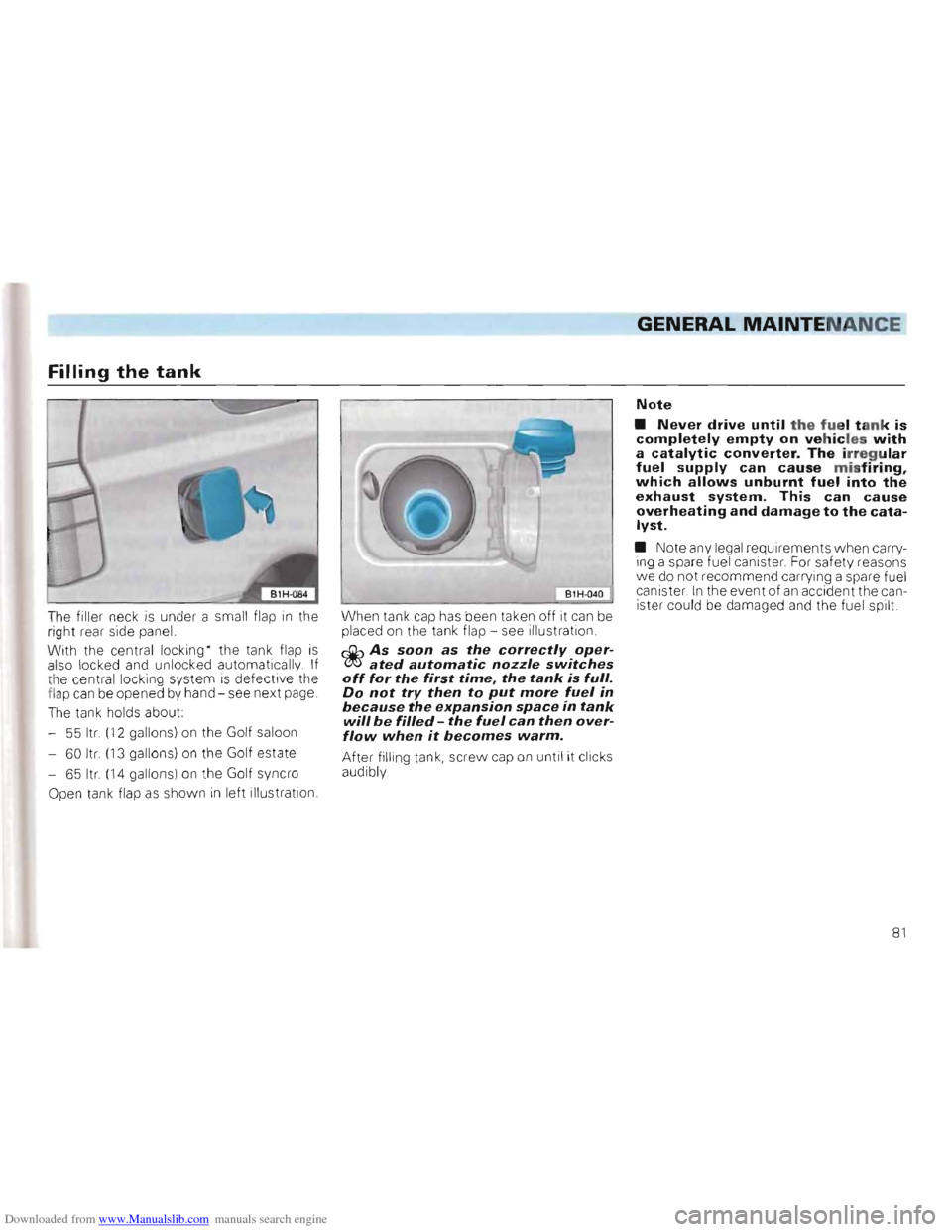
Downloaded from www.Manualslib.com manuals search engine Filling the tank
B1H-040
When tank cap has been taken off it can be
placed on the tank flap -see illustration.
r::ljb As soon as the correctly oper~ated automatic nozzle switches off for the first time, the tank is full. Do not try then to put more fuel in because the expansion space in tank will be filled -the fuel can then overflow when it becomes warm.
After filling tank, screw cap on until it clicks
audibly .
The
filler neck
is under a small flap in the
right rear side panel.
With the central locking ' the tank flap is also locked and unlocked automatically. If the central locking system is defective the fiapcanbeopenedbyhand-seene~page.
The tank holds about
-55 Itr (12 gallons) on the Golf saloon
- 60 Itr.
(13 gal lons) on the Golf estate
- 651tr .
(14 gallons) on the Golf syncro
Open
tank flap as shown in left illustr ation.
Note
• Never drive until 1he fuel tank is completely empty on vehicles with a catalytic converter. The irregular fuel supply can cause misfiring, which allows unburnt fuel into the exhaust system. This can cause overheating and damage to the catalyst.
• Note any lega l requirements when carry
ing a spa re fuel canis ter. For safety reasons we do not recommend carrying a spare fuel
canister. In the event of an accident the can
ister could be damaged and the fuel spilt.
81
Page 84 of 156

Downloaded from www.Manualslib.com manuals search engine GENERAL MAINTENANCE
Fuel
Releasing tank flap manually
If the central locking system * should become defective the flap can be released
manually :
• Open tailgate and -if
fitted -fold back
t he righ t luggage compartment trim from
side panel.
• Then reach through bet
ween body panel
and positioner and pull back loc king rod In directio n of arrow - see Illustration .
Petrol engines
Vehicles with catalyst
40. 44 and 55 kW engines
Unleaded regular petrol
RON1) not lower than 91
66 and 110 kW engines
Unleaded premium petrol
RON1) not lower than 95.
85 kW engine
Unleaded premium petrol
RON') 95
or unleaded regular petrol. 91
RON')
The use of unleaded regular petrol, with a
min imum of 91 RON ') leads to a slight loss
o f power
11 Re se arch O ctane Num b r, indicates anti
k nock properties of the pe rol
128 kW engine
Unleaded premium petrol
RON1) not lower than 95
When u sing un leaded premium petrol RON1) 98 the engine develops more pulling power (higher torque) at the same nominal output -see page 134.
140 kW engine
Unleaded premium petrol
RON') 98.
The use
of unleaded premium petrol. RON1) not less than 95. is possible without restrictions.
The automatic adaption
of the ignition tim
ing to the quality of the fuel (knock control),
can during unfavou rable operating condi
tions cause a s
light loss of performance
This can be partly compensated for by uS ing
un lead ed prem ium petro l RONlI 98 .
82
Page 85 of 156
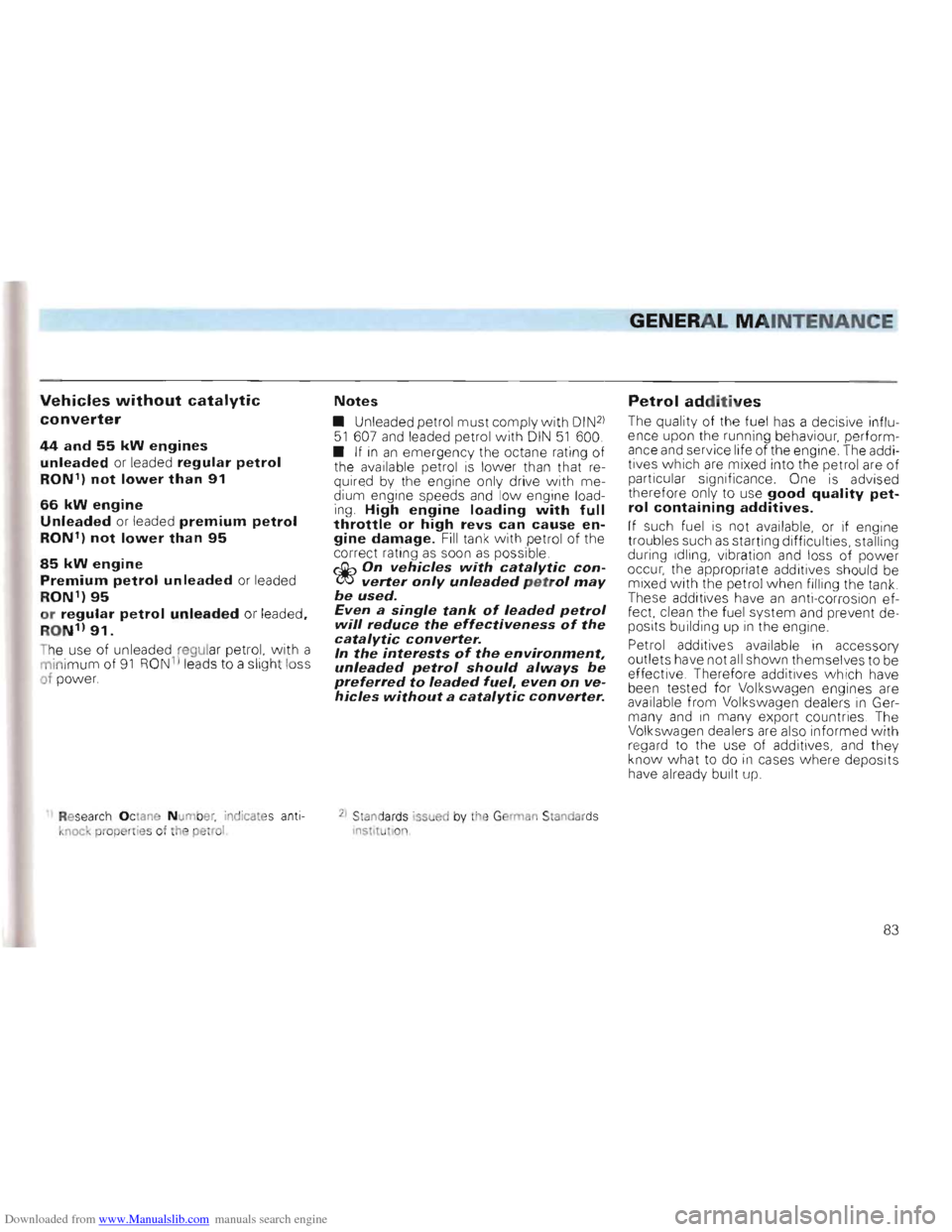
Downloaded from www.Manualslib.com manuals search engine GENERAL MAINTENANCE
Vehicles without catalytic
converter
44 and 55 kW engines
un leaded or leaded regular petrol
RON') not lower t han 91
66 kW engine
Unleaded or leaded premium petrol
RON') not lower than 95
85 kW engine
Premium petrol unleaded or leaded
RON') 95
or regular petrol unleaded or l eaded . RON1) 91.
The use of u n leaded regular petrol, with a
m inimum of 91 RON1) leads to a slight loss of power .
Research Octane Num ber , indicate s anti
knock properties o f the petrol.
Notes
• Unleaded petrol must comp ly with DIN21 51 607 and leaded petrol with DIN 51 600.
• If i n an emergency the octane rating of
the available petrol is lower than that required by the engine only drive with me
dium engine speeds and low engine load
ing. High engine loading with full throttle or high revs can cause engine dam ag e. Fill tank with petrol of the
correct rating as soon as possible &.., On vehicles with catalytic con
~verter only unleaded petrol may
be used.
Even a single tank of leaded petrol
will reduce the effectiveness of the
catalytic converter.
In the interests of the environment,
unleaded petrol should always be
preferred to leaded fuel. even on ve
hicles without a catalytic converter.
21 Stan dards issued by th e G rman Standards inslltu\l on
Petrol additives
The quality of the fuel has a decisive influ
ence upon the running behaviour, perform
ance and ser v ice life of the engine. The addi
ti ves which are mixed into the petrol are of particular sign ificance. One is advised
theref ore only to use good quality petrol containing additives.
If such fu el is not available, or if eng ine troubles such as starting difficulties, stall ing during idling, vibratio n and loss of power
occur, the approp riate additives should be mixed with the petro l w hen filling the tank.
These additives have an anti-corrosion ef
f ect, clean the fuel system and prevent de
posits building up in the engine.
Petrol additives available
in accessory
outlets have not all shown themsel ves to be effective. Ther efore additives which have been tested for Volkswagen engines are
available from Volkswagen dealers in Germany and in many export countries . The Volks wagen dealers are also informed with
r e gard to the use of additives , and they
kno w what to do in cases where deposits have already built up.
83
Page 86 of 156
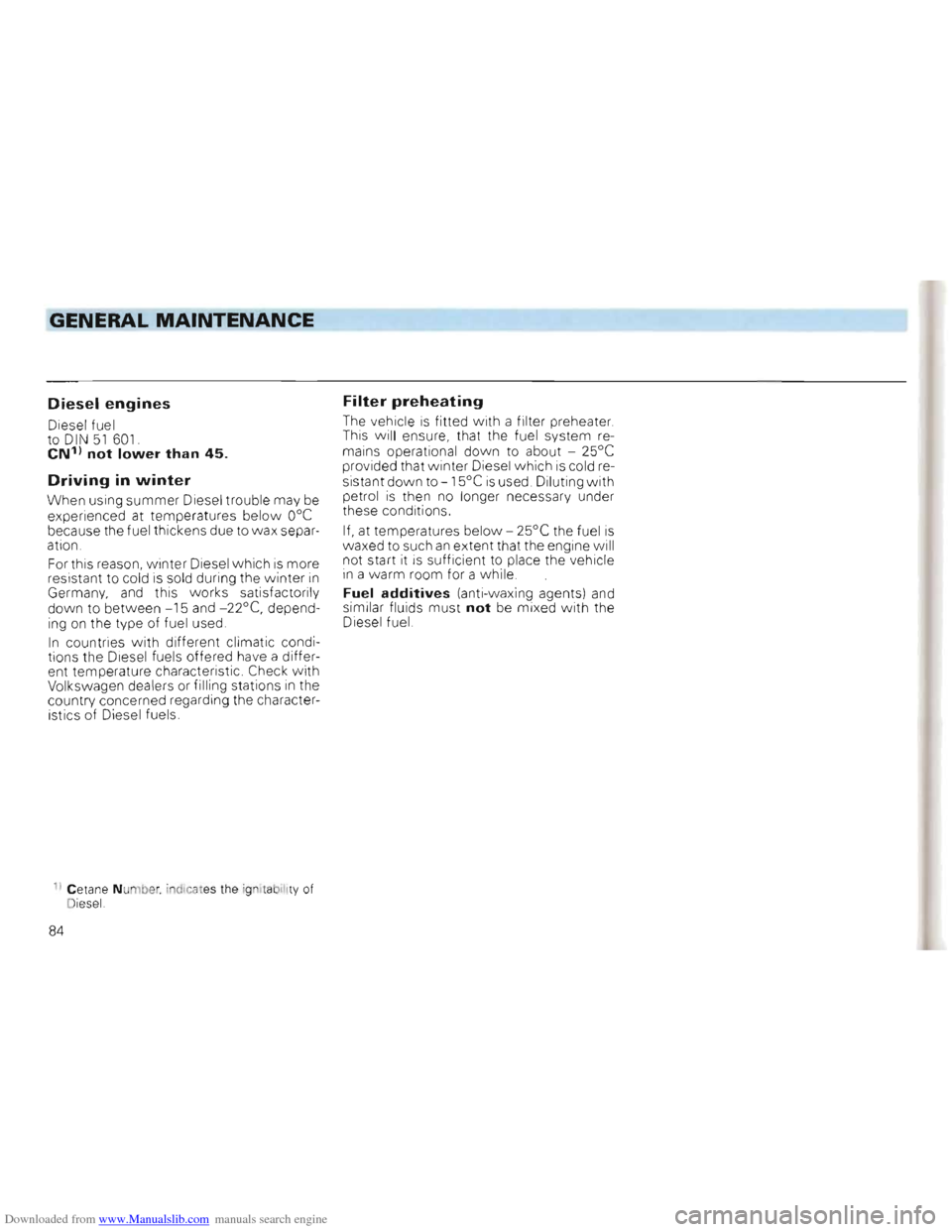
Downloaded from www.Manualslib.com manuals search engine GENERAL MAINTENANCE ~~~~~~=--------------------
Diesel engines
Diesel fuel
to DIN 51 601. eN1) not lower than 45.
Driving in winter
When using summer Diesel trouble may be experienced at temperatures below Ooe because the fuel thickens due to wax separ
ation.
For this reason, w inter Diesel which
is more
resistant to cold is sold during the winter in Germany, and this works satisfactorily
down to between -15 and -22°e, depend
ing on the type of fuel used.
In countries with different climatic condi
tions the Diesel fuels offered have a differ
ent temperature characteristic. Check with
Volkswagen dealers or filling stations
in the
country concerned regarding the character
istic s of Diesel fuels.
Filter preheating
The vehicle is fitted with a filter preheater.
This will ensure , that the fuel system remains operational down to about -25°e provided that winter Diesel which is cold resistant down to -15°e is used. Diluting with
petrol is then no longer necessary under
these conditions.
If, at temperatures below -25°e the fuel is waxed to such an extent that the engine w ill
not sta rt it is sufficient to place the vehicle in a warm room for a while .
Fuel additives (anti-waxing agents) and
similar fluids must not be mixed with the
Diesel fuel.
11 Cetane N u bee ind icates the ig nltabillty of
D iesel.
84
Page 107 of 156
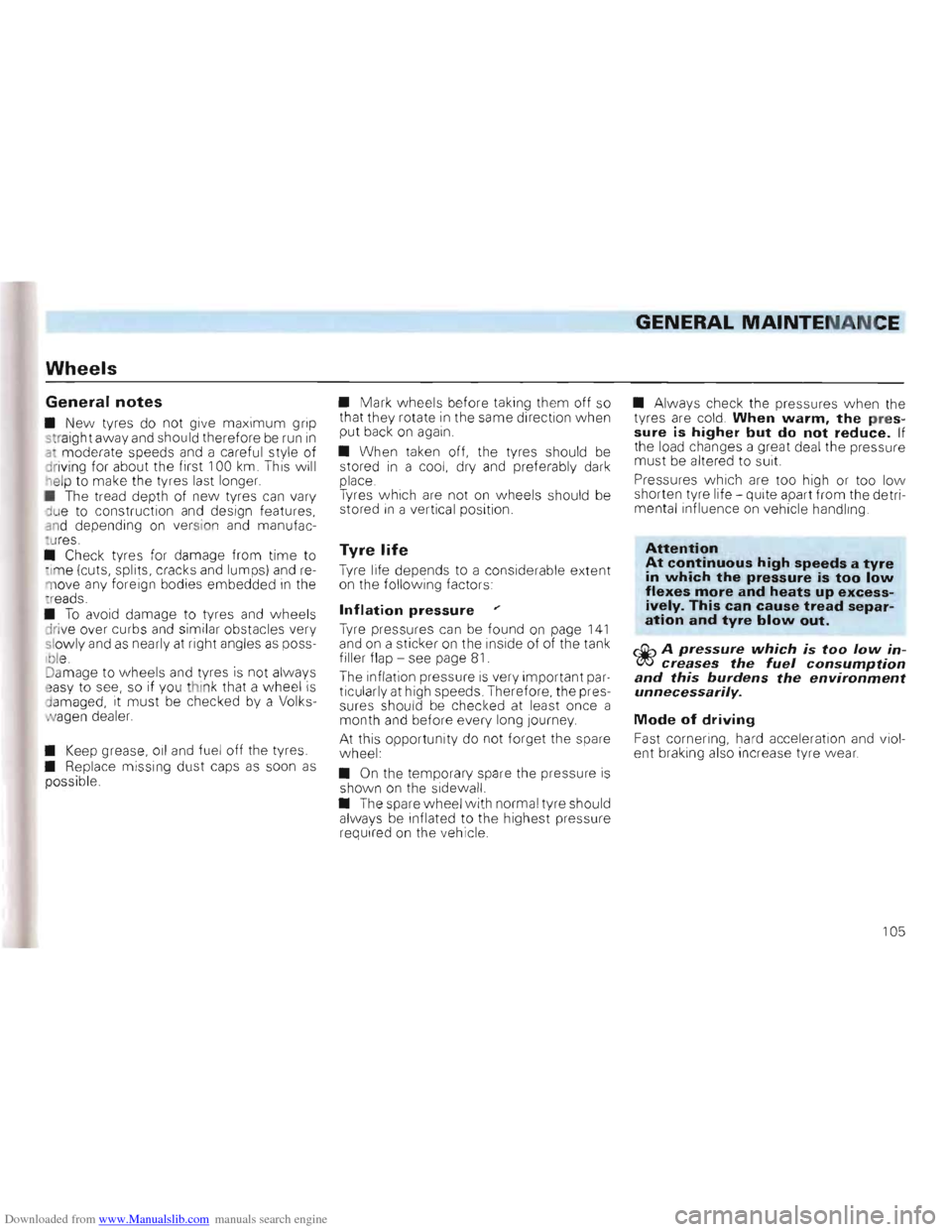
Downloaded from www.Manualslib.com manuals search engine GENERAL MAINTENANCE
Wheels
General notes
• New tyres do not give maximum grip
str aight away and should therefore be run in
a moderate speeds and a careful style of
driving for about the first 100 km . This will
"Ielp to make the tyres last longer.
• The tread depth of
new tyres can vary
du e to constructi on and design features,
and depending on version and manufac
:u res.
• Check tyres for damage from
time to
-lin e (cuts, splits, cracks and lumps) and re
m ove any foreign bodies embedded in the
- r eads.
•
To a v oid damage to tyres and wheels
drive over curbs and similar obst acles very
slowly and as nearly at right angles as poss
Ible .
Damage to w he els and tyres is not always
e asy to see, so if you think that a wheel is
d a maged, It must be checked by a Volks
w agen dealer.
• Keep grease,
011 and fuel off the tyres.
• Replace missing dust caps as soon as possib le.
• Mark wheels before taking them off so
that they rotate in the same direction when put back on again
•
When taken off, the tyres should be
stored in a cool, dry and preferably dark
place
T y res
which are not on wheels shou ld be
stored In a vertical position.
Tyre life
Tyre life depends to a considerable extent
on the following factors:
Inflation pressure ..-
Tyre pressures can be found on page 141
and on a sticker on the inside of of the tank
filler flap -see page 81.
The inflation pressure
is very important par
ticularly at high speeds . Therefore, the pres
sures should be che cked at least once a
month and before every long Journey.
At this opportunity do not
forget the spare
w heel
• On the temporary spare the pressure is shown on the side wall.
• The spare
wheel w ith normal tyre shou ld alw ays be inflated to the highest pressure required on the veh icle. •
Always check the pressures
when the
ty res are cold. When warm, the pressure is higher but do not reduce. If the load changes a great deal the pressure must be altered to suit.
Pressures
which are too high or too low short en tyre life -quite apart from the detrimental influence on vehicle handling .
Attention
At continuous high speeds a tyre
in which the pressure is too low
flexes more and heats up excess
ively. This can cause tread separ
ation and tyre blowout.
dit-. A pressure which is too low in~creases the fuel consumption and this burdens the environment unnecessarily.
Mode of driving
Fast cornering, hard acceleration and Viol
ent braking also increase tyre wear.
105
Page 111 of 156
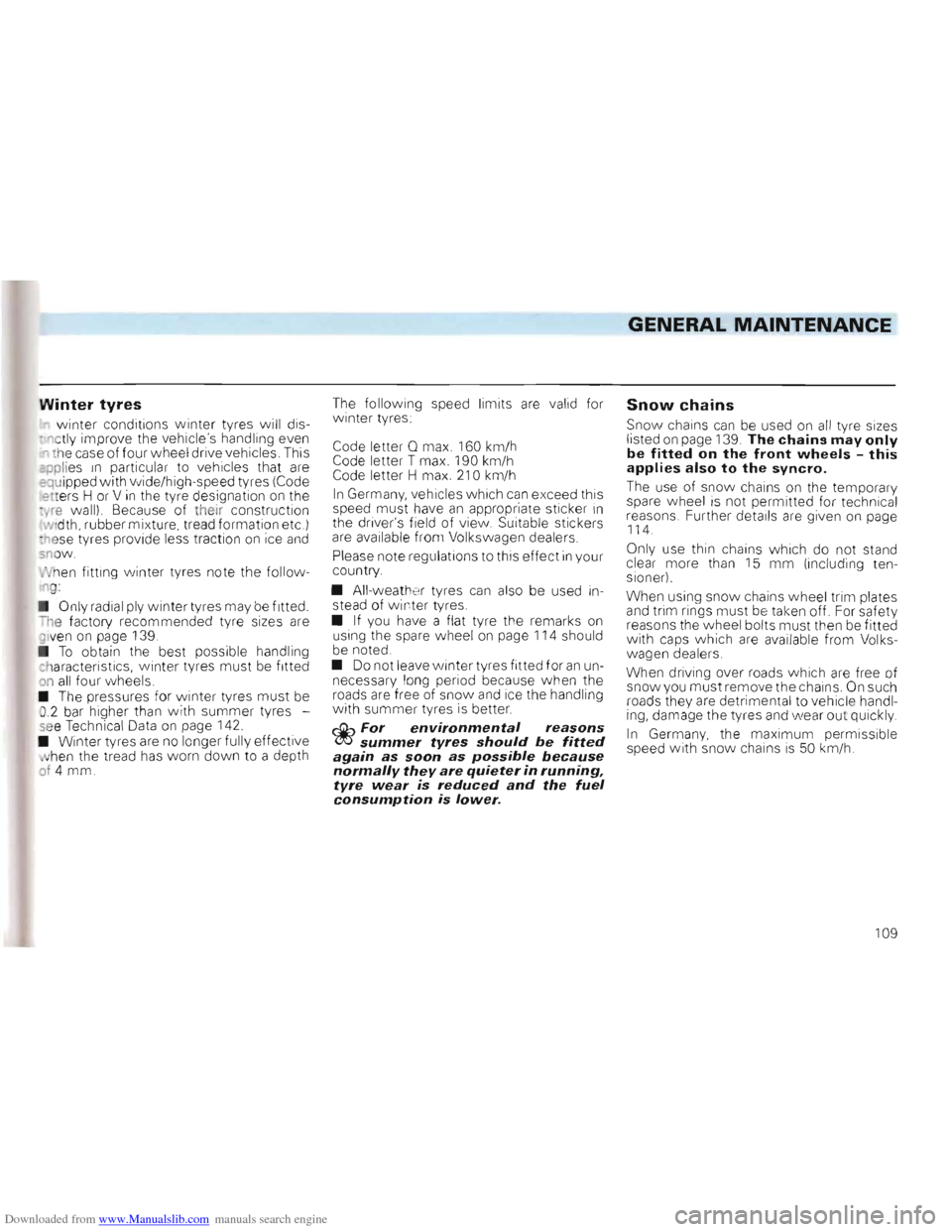
Downloaded from www.Manualslib.com manuals search engine GENERAL MAINTENANCE
Winter tyres
winter conditions win ter tyres w ill dis
- n ctly improve the vehicle's handling even
th e case of four
wheel drive ve hicles. This
ap plies In particular to veh icles that are
eq uipped with wide/high -speed tyres (Code
e
tters H or V in the tyre designation on the
: r e wall). Because of their construction
,lIdth, rubber mixture, tread formation etc) :n se tyres provide less traction on ice and
sn ow.
h
en fitting winter tyres note the follow
n g:
• Onl y radial ply winter tyres may
be fitted.
h e factory recommended tyre sizes are given on page 139.
•
To obtain the best possible handling ch aracteristics, wint er tyres must be fitted o n all fou r wheels.
• The pressures for
winter tyres must be
0.2 bar higher than with summer tyres
s e e Technical Data on page 142.
•
Winter tyres are no longe r fully effec tive
h en the tread has worn down to a depth
o f 4 mm.
The following speed limits are valid for winter tyres:
Code letter
Q max. 160 km/h
Code letter T max. 190 km/h
Code letter H ma
x. 210 km/h
In Germany, vehicles w hich can exceed this
speed must have an appropriate sticker in the driver's field of view. Suitable stickers
are available from Volkswagen dealers.
Please note regulations to this effect
in your
cou ntry .
• All-weath er t yres
can also be used in
stead of winter ty res .
• If you have a flat tyre the remarks on
using the spare wheel on page 114 should
be noted .
•
Do not leave winter tyres fitted for an un
necessary long period because w hen the
roads are free of
snow and ice the handling with summer tyres is better.
r:lil:.-. For environmental reasons (!Jtf summer tyres should be fitted again as soon as possible because normally they are quieterin running, tyre wear is reduced and the fuel consumption is lower_
Snow chains
Snow chains can be used on all tyre sizes
listed on page 139. The chains may only be fitted on the front wheels -this applies also to the syncro.
The use of sno w chains on the temporary
spare wheel is not permitted for technical
reasons. Further details are given on page
114 .
Only use thin chains w hich do not stand
clea r
more than 15 mm (including ten
sioner).
When using snow chains wheel trim plates
and trim rings must be ta ken off . For sa fety
reasons the w heel bolts must then be fitted with caps w hich are available from Volks
wagen dealers.
When driving over roads whic h are free of snow you must remo ve the chains. On such
road s they are detrimental to vehic le handl
ing, damage
the tyres and wear out Quickly .
In Germany , the maximum permissible
speed w ith snow chains is 50 m/h
109